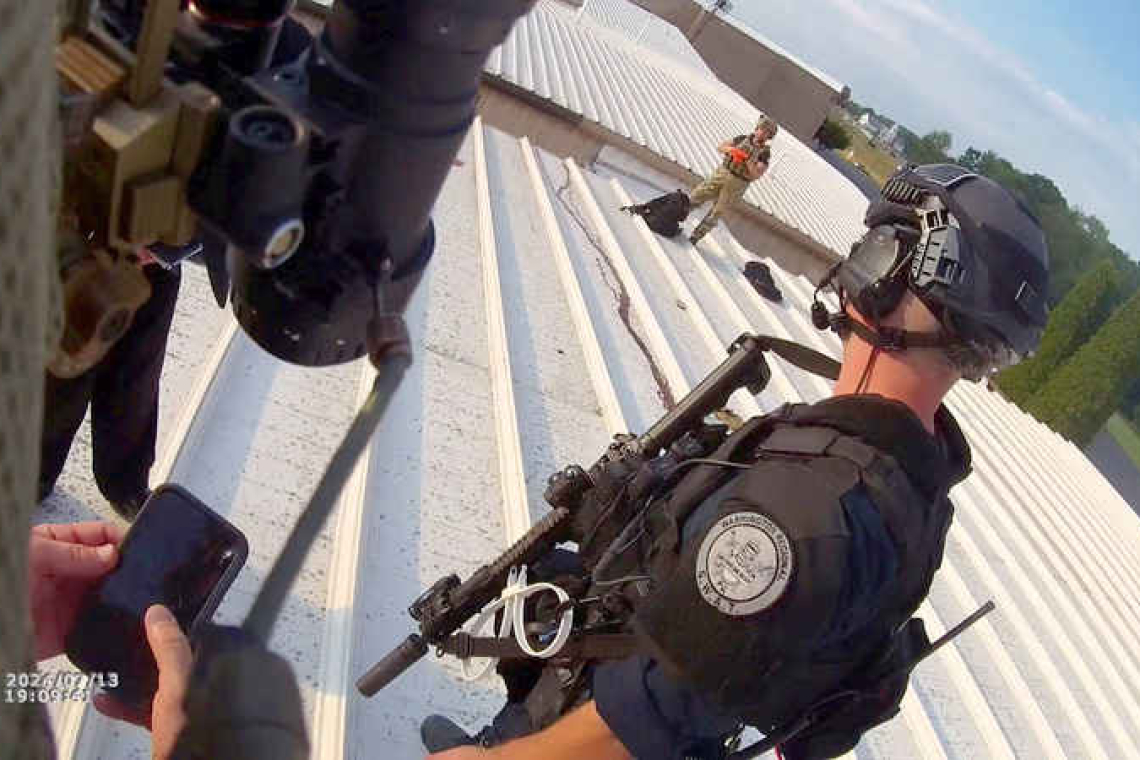Law enforcement officers stand near the body of a gunman after the assassination attempt on former President Donald Trump during a campaign rally, in Butler, Pennsylvania, U.S., July 13, 2024 in this still image taken from bodycam video. (Beaver Co Emergency Services Unit via Chuck Grassley/Handout via Reuters)
WASHINGTON--The 20-year-old gunman who tried to kill Donald Trump did an online search of the John F. Kennedy assassination around the time he began to focus attention on the Republican presidential candidate, FBI Director Christopher Wray said on Wednesday. Wray told the U.S. House Judiciary Committee that suspect Thomas Crooks visited the Trump rally site in Butler, Pennsylvania, twice before he clambered onto the roof of a nearby building on July 13 and fired off at least eight rounds, wounding Trump in the ear, killing one rally-goer and injuring two others.
"Analysis of a laptop that the investigation ties to the shooter reveals that on July 6, he did a Google search for -quote - 'how far away was Oswald from Kennedy,'" Wray said. He was referring to Lee Harvey Oswald, who assassinated former President Kennedy in Dallas, Texas, on Nov. 22, 1963. "That's a search that's obviously significant in terms of his state of mind," Wray said. "That is the same day that it appears that he registered for the Butler rally," he added, saying Crooks became "very focused on President Trump and his rally" at that point after showing interest in public figures more generally. About two hours before the shooting, Crooks flew a drone over the area about 200 yards (180 meters) from the stage where Trump spoke to the crowd, and live-streamed footage for about 11 minutes. Law enforcement officers did not spot Crooks on the roof with his AR-15-style rifle until "seconds" before he opened fire, said Wray, noting that the timeline could change as the investigators' understanding of facts evolves. "It's all happening in seconds," Wray said. He added that the rifle had a collapsible stock, "which could explain why it might have been less easy for people to observe." Crude explosive devices later recovered from Crooks' car and home were designed to be detonated remotely. Crooks had a transmitter with him, Wray added. But he said the FBI believes the suspect would not have been successful had he tried to detonate the devices. The motive for the shooting remains unclear. Wray said many people have described Crooks as a loner and the list of contacts in his phone was short. The hearing also focused on the increasingly tense political atmosphere surrounding the presidential campaign. "I have been saying for some time now that we are living in an elevated-threat environment. And tragically, the ... assassination attempt is another example, particularly heinous," Wray testified. A day before Wray's testimony, Kimberly Cheatle resigned as director of the U.S. Secret Service after bipartisan demands to quit over the failure to prevent the attempted assassination. Judiciary Committee Chairman Jim Jordan welcomed Wray's willingness to share details about the FBI investigation into the assassination attempt. But he also cited skepticism toward the FBI that exists among some Republicans, who are angry about the arrest of Trump supporters who stormed the U.S. Capitol on Jan. 6, 2021, as Congress certified President Joe Biden's 2020 election victory. "I'm sure you understand that a significant portion of the country has a healthy skepticism regarding the FBI's ability to conduct a fair, honest, open and transparent investigation," Jordan said. Representative Jerrold Nadler, the panel's top Democrat, condemned the Trump shooting "unequivocally and unabashedly" but pointed to years of political threats and violence, and violent rhetoric from Republicans including Trump himself. "If you think that this one assassin's bullet was a bolt out of the blue, and not part of a wave of violence that has threatened this nation for years, then you have missed the point," Nadler said.







